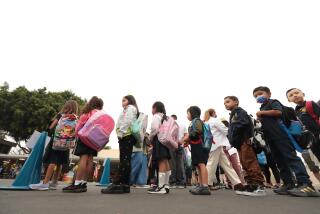Flexibility in Class Sizes
- Share via
Re “Flexibility in Class Reduction,” editorial, June 16:
As a first-grade teacher with 18 students I have seen the impact of class-size reduction on the academic and social growth of my students. What concerns me is the idea that team teaching (i.e., 40 kids with two teachers in one classroom) can afford the students the same outcome. This situation has none of the benefits of 20 kids in one classroom with one teacher.
With 20 kids, the level of noise is greatly diminished, allowing greater concentration; the transition time between activities and the time it takes for everyone to complete a task is greatly reduced, allowing for more teaching time.
Districts like Downey, where I teach, that have only reduced class sizes where they could reasonably hire qualified teachers and provide classroom space will be judged together with districts that have been irresponsible with their decisions. Unfortunately for all students, if this program does not show that students are making significant academic growth across the state, the politicians will be quick to cut off funding.
KIM WILLOUGHBY
Fullerton
Local school districts could use a bit more flexibility in managing class-size reduction. Districts would be better able to utilize the limited resources and classroom space if the program were amended to make the 20-to-1 class cap figure a districtwide average. Raise the current absolute class cap to 22 students.
Sure, some classes would have 22 students, still a huge improvement, but others would have 18. Students don’t always come in “20 packs.”
BEN RICH, Board Member
Chino Unified School District






